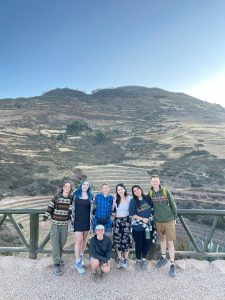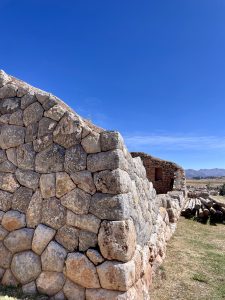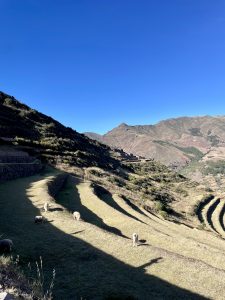

 The last few days in Pisac I’ve had the opportunity to visit a few different Incan ruins in both Pisac itself and in the surrounding towns. Each time we’ve visited I’m struck by the same awe but also an odd sense of confusion or “inquietud” which is a word I seem to only know in Spanish and I’m not bothered to find out in English because it suits me so well as it is.
The last few days in Pisac I’ve had the opportunity to visit a few different Incan ruins in both Pisac itself and in the surrounding towns. Each time we’ve visited I’m struck by the same awe but also an odd sense of confusion or “inquietud” which is a word I seem to only know in Spanish and I’m not bothered to find out in English because it suits me so well as it is.
In Pisac, the ruins are way up high on a hill side as opposed to being nestled in the valley where the modern city of Pisac is. This meant that the residents could not only take advantage of the agriculture by elevation system, but had the advantage of gravity being on their side. A local guide told us the Incans primary weapon against enemies was the slingshot and I noticed Daniel practicing his marksmanship from the tippy top of the fortification. He was confident he could defend the terraces (no tourists or llamas were harmed in this recreation). But the genius of the incas extended even further, they understood that the hillside rock was more stable that the slope across the valley and chose to place their settlement for longevity instead of ease of construction. Note: that unstable hill side is now completely occupied…
In Chinchero and Moray we also got to visit the fruits of Incan labor. Chinchero had more terraces than fort ruins and Moray was basically a really high tech pit. Apparently at Moray, the Incans conducted agriculture research and it was a kind of lab space. The terraces descend from a ledge concentrically like a telescope. They are incredibly symmetrical and obviously precise. The walls are, of course, perfectly designed and aligned. The sheer scale of Moray is hard to describe. We were there during sunset and it felt like the site had eaten up the afternoon sun itself to lend a blueish haze to everything. In the background Salkantay and Ausegante (?) tower over the valley. Imposing and powerful in the same but opposite way as the Moray pit.
And now “mi inquietud”. Real people lived in these places. Real people live laugh loved at the Pisac ruins. They played games, they made jokes, they fought with their siblings etc. And now they’re just not here. And now we just wander around and look at the graveyards of their existence. It’s fascinating but it’s really very morbid. Cissy and I were chatting on the walk around Moray about why the terraces aren’t in use anymore, they seem totally structurally sound and there is a lot of land not being used. We thought about it for a bit and felt that if the lands were being worked on and the site was also open to visitors (which I think it should be as there is value in remembering history), that it would become a sort of zoo. People would come and gawk at the workers, similar to how we all act when we see llamas. It would devalue the site and be disrespectful of the people.
So this made me think, are we still treating these sites as respectfully as we can while also learning from them? Is it effectively a zoo of the past?
5 replies on “ruins: got wreckt :(”
Your question got me thinking about the circus or sideshow, whatever that was we went by as we went to and from the archaeological sites yesterday. It gave me big “freak show” vibes, and of course, I had to crack a joke about it, but in reality, I sure hope it wasn’t. I also hope we are not treating the ruins similarly, just as something to gawk at. I personally feel that the ability to see the ruins up close like we did helps me to connect in a new way. I have always felt a connection to the history of Peru, maybe connection is not the right word, perhaps instead I should say I have been interested in them in a way that goes beyond just curiosity. Being here has made me appreciate what I have been learning in an entirely different way.
Hi Morgan,
Thank you for this summary of learnings along with your personal insights! I’m still thinking about what it means to learn respectfully from historical sites. In my classes, we’ve discussed national parks and their version of conservation termed “fortress conservation”, which is when nature is “preserved” by preventing anybody (except tourists!) from accessing the land. This is in spite of the fact that Indigenous peoples have been working with and shaping this land since time immemorial. This is the background knowledge I come from, but I don’t think this applies in the same way to historical sites. So I’m still learning.
Also, I just think it’s so incredibly cool that Moray was an agricultural research facility of sorts! So much cooler than UBC Farm (no offense UBC Farm). I think it goes to show that pre-colonial cultures did indeed have technology and innovation, but often not in ways that we would recognize as such. If a peoples thrived in a place for a long time, they MUST have learned to work with the land and continually adapt. Thank you for bringing up these important conversations.
Take care,
Cissy
Hi Morgan! I really enjoyed visiting the ruins with you. Thank you for being our honourary Spanish speaker and making the process much more fluid and entertaining. Regarding the absent use of the terraces, I’m not sure why they are not in use anymore but it may be because they have developed other more accessible areas to farm. When we were visiting the paka paka sight we saw many terraces near the tops of mountains and I can’t imagine them utilizing those spaces easily. Due to most of the sites being reconstructed, I think being able to enter the space but also having many spaces restricted is a nice balance between engaging with the history but also preserving the ruins.
“Is it effectively a zoo of the past?” This question is precise, too precise. I think it summarizes many of the “inquietudes” that have been accumulating over the days, from our invasions as tourists in archaeological sites. But I think that in some way we have also inhabited part of those ruins. For example, many of the buildings in Cusco in which we have eaten, laughed and stayed together are remains of those ruins, rebuilt under other urban planning principles, but they are also something more, they are habitable spaces too.
Hi Morgan, this post took me right back to visiting the ruins with you all! 🙂 I find the sentence “We were there during sunset and it felt like the site had eaten up the afternoon sun itself to lend a blueish haze to everything” especially beautiful, I found the sunset and blue haze really lovely when we were there and I like the idea of the site eating up the sun… I think you’ve captured the complexities and emotions that arise when visiting ruins so well, as well as the idea of how people and spaces might be treated if ruins were still in use today…